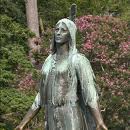Pocahontas is difficult to separate from the myth perpetrated everywhere from a painting in the halls of US Congress, a statue in Jamestown, Virginia to a Disney feature film.
She has drawn increasing attention marking the founding of the Jamestown settlement that were being billed as America’s 400th anniversary.
Many places around the US named after the girl, the English sisters called her a princess, who John Smith later claimed saved his life from the hostile Indians moments before he would have been executed.
The legend goes that Jamestown colonist John Smith was captured and dragged before Powhatna at his capital, Werowocomoco.
Years later, Smith described the encounter in his memoirs, saying Indians ready to beat him to death with clubs. He said Pocahontas rushed up and lay over his head to save his life.
But Smith was known at the time as a braggart and the timing of the account draws into question whether it actually occurred, historians say.
If it did happen, the incident was likely part of an adoption ritual and Smith’s life was not actually endangered, a Jamestown historian say at the various museums dedicated to the colony.
Pocahontas, whose real name was actually Matoaka, the daughter of Powhatna, chief of the tribes. She would have been a young girl of around ten years old at the time, not of curvaceous young woman of Disney fame.
Myths that Pocahontas and John Smith has a romantic relationship as they did in the Disney film are also false, though her relationship with the settlers certainly helped them survive.
The legends persist to this day, much to the chagrin of some native Americans. A monument to Pocahontas stands on tribe’s reservation about an hour from Jamestown.
Smith, who wrote that Pocahontas saved the colony from “death, famine and utter confusion”, himself played a crucial role in saving Jamestown from starvation.
During his brief stint as leader, he instituted a no work no food policy to alleviate problems with people more interested in digging for gold than finding food.
Smith also charted and explored much of the Chesapeake Bay before returning to England.
Pocahontas seems to have married a fellow Native American, but was later taken captive by the English settlers and held for more than a year. After that time, she married an English man, John Rolfe, who was crucial in introducing tobacco as a cash crop to Virginia.
She was baptized as Rebecca Rolfe in 1614. They traveled to England in 1616 as part of the promotional voyage to boost the colony, and she was widely in royal circles.
Before she could return home to Virginia, she feel ill, died at the age of twenty two and was buried in England. The couple had one child, Thomas Rolfe.
